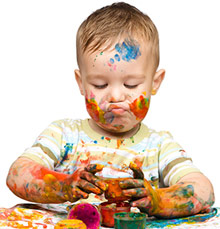
|
Thinking About Thinking
|
|
||||||||||
 We all know that people have different ways of processing information and solving problems. The way we think about things impacts how we deal with them. One important way to categorize our thinking style is by understanding “convergent” and “divergent” thinking. Knowing the difference between these two styles also provides insight into how young children view the world and is a critical component of creativity. Convergent Thinking Convergent is from the word converge, meaning “to come together.” Convergent thinkers see a limited, often predetermined, single or small amount of options. For example, people who are good at math are often good convergent thinkers. One plus one equals two. There is no other answer. Standardized tests and formal schooling focus on convergent thinking. Divergent Thinking Divergent means “developing in different directions,” so divergent thinkers either see or look for multiple options. Many times there is no “right” answer just different possibilities. For example, art utilizes divergent thinking. So does brainstorming. Why is This Important? Knowing how we think can inform our world view and help us expand how affective we are at dealing with problems. For example, if you are a convergent thinker and you have a difficult problem to solve, challenge yourself to look beyond just the few possibilities that may initially come to mind. If you are a divergent thinker be sure to come up with all your possibilities but then narrow it down to what is most effective. Children Are Natural Divergent Thinkers Most young children are natural divergent thinkers. To a young child a necktie can be a lasso. A tree branch can be a sword. Your favorite crystal vase can be a piece of falling ice. As parents we teach our children what objects are for and inform their worldview. For example, a fork is for eating and not combing hair. This process discourages divergent thinking and encourages convergent thinking. It is important to help children understand and make sense of their world, but can detract from their natural ability to think divergently. When children begin formal education, convergent thinking is paramount and there is little room left for divergent thinking. |
|||||||||||
|
Finally, most children end up like most adults, competent at convergent thinking but less efficient at divergent thinking.
Becoming a strong convergent thinker is not necessarily problematic and is actually more helpful in our society, but being able to think divergently does have many benefits and is sometimes a necessary tool. For example, being able to think outside of the box is prized in many businesses and it allows for innovation even in science and math. Divergent thinking is one of the most critical components of creativity. In fact, in our society, what we think of as creativity is often just divergent thinking. However, creativity is really the marriage of being able to think divergently and convergently. Creativity Creativity is typically regarded in America as a positive character trait and research has linked it with the ability to find and solve problems more readily. Although creativity is an important skill, little is done to maintain or cultivate it. In fact, creativity in children has been on the decline since 1990 with kindergarten through sixth grade showing the greatest decrease. Research studies have yet to determine why American creativity is on the decline, but possible culprits are TV and video games. One study concludes that for every hour a child watches TV it reduces the amount of time they have to be creative by as much as 11%. Also, schools and parents often push and reward children more heavily for convergent rather than divergent thinking. This is unfortunate as creativity can play a central role in child and adult success. Countless research has demonstrated this. For example:
|
|||||||||||
 |
|||||||||||
